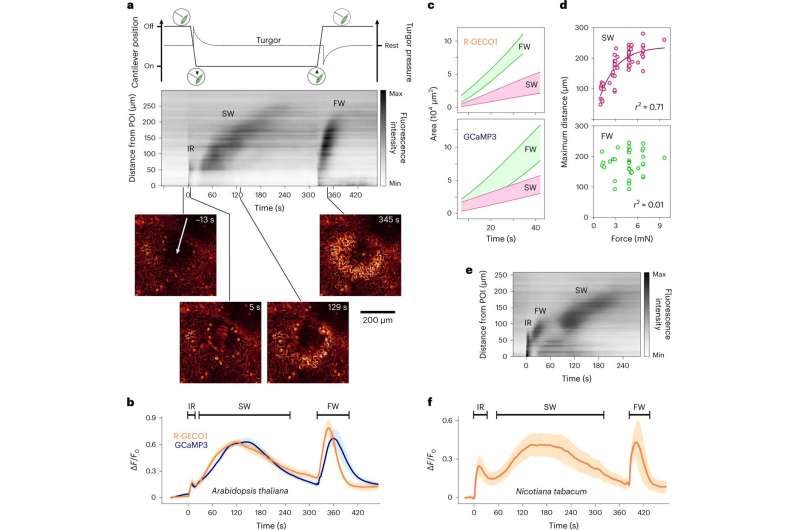This article has been reviewed according to Science X's editorial process and policies. Editors have highlighted the following attributes while ensuring the content's credibility:
fact-checked
peer-reviewed publication
trusted source
proofread
Plants can distinguish when touch starts and stops

Even without nerves, plants can sense when something touches them and when it lets go, a Washington State University-led study has found.
In a set of experiments, individual plant cells responded to the touch of a very fine glass rod by sending slow waves of calcium signals to other plant cells, and when that pressure was released, they sent much more rapid waves. While scientists have known that plants can respond to touch, this study shows that plant cells send different signals when touch is initiated and ended.
"It is quite surprising how finely sensitive plants cells are—that they can discriminate when something is touching them. They sense the pressure, and when it is released, they sense the drop in pressure," said Michael Knoblauch, WSU biological sciences professor and senior author of the study in the journal Nature Plants. "It's surprising that plants can do this in a very different way than animals, without nerve cells and at a really fine level."
Knoblauch and his colleagues conducted a set of 84 experiments on 12 plants using thale cress and tobacco plants that had been specially bred to include calcium sensors, a relatively new technology. After placing pieces of these plants under a microscope, they applied a slight touch to individual plant cells with a micro-cantilever, essentially a tiny glass rod about the size of a human hair. They saw many complex responses depending on the force and duration of the touch, but the difference between the touch and its removal was clear.
Within 30 seconds of the applied touch to a cell, the researchers saw slow waves of calcium ions, called cytosolic calcium, travelling from that cell through the adjacent plant cells, lasting about three to five minutes. Removal of the touch showed an almost instant set of more rapid waves that dissipated within a minute.
The authors believe these waves are likely due to the change in pressure inside the cell. Unlike animal cells with permeable membranes, plant cells also have strong cellular walls that cannot be easily breached, so just a light touch will temporarily increase pressure in a plant cell.
The researchers tested the pressure theory mechanically by inserting a tiny glass capillary pressure probe into a plant cell. Increasing and decreasing pressure inside the cell resulted in similar calcium waves elicited by the start and stop of a touch.
"Humans and animals sense touch through sensory cells. The mechanism in plants appears to be via this increase or decrease of the internal cell pressure," said Knoblauch. "And it doesn't matter which cell it is. We humans may need nerve cells, but in plants, any cell on the surface can do this."
Previous research has shown that when a pest like a caterpillar bites a plant leaf, it can initiate the plant's defensive responses such as the release of chemicals that make leaves less tasty or even toxic to the pest. An earlier study also revealed that brushing a plant triggers calcium waves that activate different genes.
The current study was able to differentiate the calcium waves between touch and letting go, but how exactly the plant's genes respond to those signals remains to be seen. With new technologies like the calcium sensors used in this study, scientists can start to untangle that mystery, Knoblauch said.
"In future studies, we have to trigger the signal in a different way than has been done before to know what signal, if touch or letting go, triggers downstream events," he said.
More information: Alexander H. Howell et al, Pavement cells distinguish touch from letting go, Nature Plants (2023). DOI: 10.1038/s41477-023-01418-9
Journal information: Nature Plants
Provided by Washington State University

















